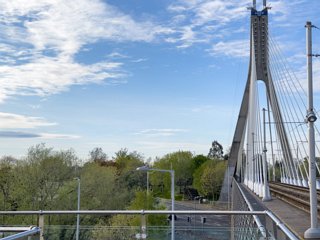WILLIAM DARGAN BRIDGE
The William Dargan Bridge: Dublin's Luas Landmark
Located in Dundrum, Dublin, the William Dargan Bridge is a striking example of modern engineering. This cable-stayed bridge stands out as a prominent landmark, carrying the Luas Green Line (Dublin's light rail system) over the busy Taney Road junction.
Design
The bridge features a distinctive inverted-Y shaped pylon that rises 50 meters (164 feet) tall. The main span stretches across an impressive 108.5 meters (354 feet) and is supported by 13 pairs of high-tensile steel cables.
Construction
The bridge's deck is made of slim, curved prestressed concrete. It was built using an innovative technique involving precast segments that were assembled and filled within-situ concrete for added strength.
Significance
Opened in 2004, the William Dargan Bridge re-established a crucial section of the former Harcourt Street railway line, which had been closed for decades.
Awards and Recognition
The William Dargan Bridge has received several prestigious awards like the ACEI (Association of Consulting Engineers of Ireland) President's Award for Excellence and the Irish Concrete Society Award.
William Dargan's Legacy in Irish Railways
William Dargan (1799-1867) was a pivotal figure in shaping Ireland's railway infrastructure. He played a vital role in both the Dublin area and beyond:
Dublin and Kingstown Railway
Dargan served as the driving force behind Ireland's first railway line.
Belfast Bridge
In Belfast, the Dargan Bridge, a railway bridge crossing the River Lagan, honors his legacy. This bridge was instrumental in connecting formerly disjoint railway lines in Northern Ireland and boosting the local economy.
Nationwide Impact
Dargan's extensive railway projects connected regions across Ireland, positively impacting travel, trade, and economic growth.

WILLIAM DARGAN BRIDGE
SELECT AN IMAGE TO VIEW SLIDESHOWS